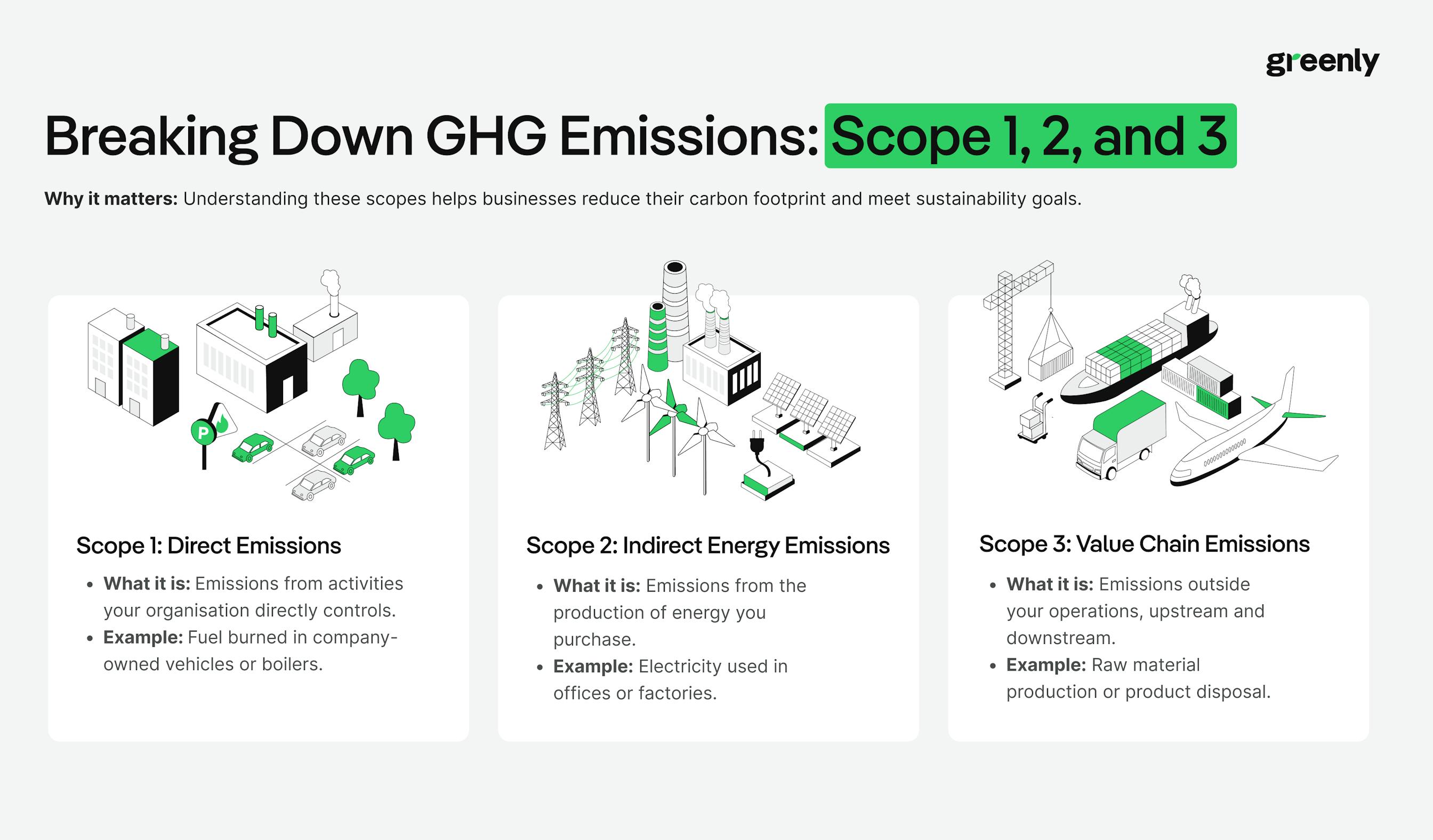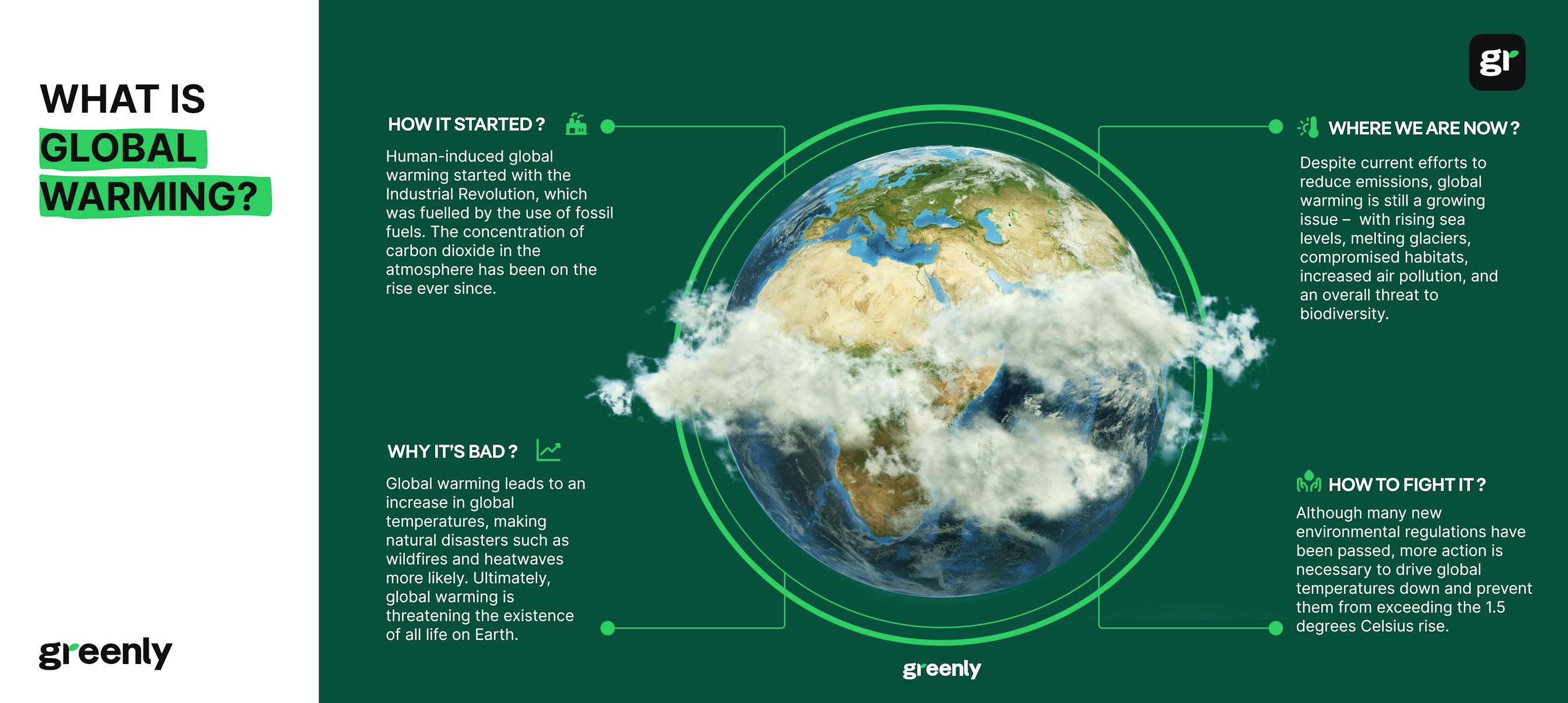
ESG criteria: what you need to know
What exactly do ESG criteria involve, and how do they impact businesses? Let’s take a closer look.
ESG / CSR
Industries



In the race to reduce greenhouse gas (GHG) emissions, the Greenhouse Gas Protocol has established critical guidelines that serve as a benchmark for businesses and governments to measure and manage emissions. Its standards are internationally recognized and extensively used, forming the core framework for carbon accounting in the CDP (Carbon Disclosure Project) and various environmental, social, and governance (ESG) frameworks.
Whether or not you've heard of the Greenhouse Gas Protocol, you can probably guess that emissions reduction is meaningless without standards for measurement.
Developed in the late nineties by the World Resources Institute (WRI) and the World Business Council for Sustainable Development (WBCSD), the GHG protocol emerged at a time when global efforts to address climate change and reduce emissions were just starting to take off. Today, it offers some of the most widely accepted standards for measuring and reporting greenhouse gas emissions.
Its guidelines are used by governments, cities, companies, and organizations to translate their activities into quantifiable inventories of CO2 and other emissions data.
👉 Understand the Greenhouse Gas Protocol and its role in emissions reporting. Explore its standards, including Scope 1, 2, and 3, and how it helps businesses reduce their carbon footprint.
The purpose of the Greenhouse Gas Protocol is twofold: It helps us track and monitor emissions for individual entities and supports greenhouse gas reductions by helping companies identify the most effective ways to reduce their climate impact.
Reducing the level of greenhouse gases in the atmosphere is crucial to prevent further global temperature rise and mitigate the impacts of climate change. As GHG emissions contribute significantly to global warming, their reduction is essential for a sustainable future. The GHG Protocol and GHG accounting play pivotal roles in this endeavour by providing companies with a clear framework to measure and report their emissions accurately. This enables organizations to identify key areas where emissions can be reduced and to track their progress in implementing effective climate action strategies. By standardizing these measurements, the GHG Protocol ensures that efforts to reduce emissions are both effective and comparable across different sectors and regions.
The Greenhouse Gas Protocol was established in 1998 by the World Resources Institute (WRI) and the World Business Council for Sustainable Development (WBCSD) in response to growing global concerns about climate change. At the time, businesses and organizations faced significant challenges in measuring and reporting their greenhouse gas (GHG) emissions due to the lack of a standardized framework. This inconsistency created barriers to meaningful climate action, making it difficult for companies to benchmark their performance, for stakeholders to evaluate emissions data, and for governments to design effective policies.
Developed through a collaborative process involving experts from business, government, and non-profits, the Protocol created a shared language for tracking emissions, enabling organisations to identify their emissions sources, set reduction targets, and monitor progress. Today, it remains a cornerstone of global climate action, widely regarded as the gold standard for greenhouse gas accounting and reporting.
The Greenhouse Gas Protocol established the most well-known system for greenhouse gas emissions measurement with its Scope 1, 2, and 3 emissions categories. But this only covers one part of its work.
The Greenhouse Gas Protocol's contribution goes beyond its well-known system of categorizing greenhouse gas emissions into Scope 1, 2, and 3. The Protocol has also developed standards tailored for a variety of specific situations and applications. These standards are not static; they are updated over time to stay relevant and effective. For example, in 2019 the Greenhouse Gas Protocol launched its Partnership for Carbon Accounting Financials (PCAF) initiative. It aims to develop a global standard for the financial industry to report on GHG emissions related to investments.
Additionally, the GHG Protocol has created tools and training programs to assist in more accurate and efficient calculation and reporting of greenhouse gas emissions.
💡 Since the Paris Agreement was signed in 2015, the GHG Protocol has expanded to include various standards and tools allowing governments and cities to track climate action.


Climate change is a challenge defined by identifiable factors; it is well-understood that greenhouse gas (GHG) emissions are driving the global temperature rise, and the specific activities leading to these emissions are known.
The tricky part is getting everyone to reduce their emissions in a clear and consistent manner. Accounting for these reductions requires data, so companies need guidelines for data collection, measurement, and reporting. The Greenhouse GasProtocol standards make it easier to do these things.
To develop standards that are useful to all kinds of entities, the GHG Protocol spends time working with governments, NGOs, industry associations, and businesses to develop useful standards for lowering emissions. It regularly updates its standards and adds new ones for specific use cases.
In essence, the Protocol supports a data-driven approach to addressing climate change. This helps make the alarming, complex, and long-term problem of climate change more manageable.
The GHG Protocol aids organizations in advancing their climate action efforts by identifying key priorities for reducing GHG emissions, encompassing both direct and indirect emissions within their operations and across their value chains. This way, companies can gain clarity on the most impactful actions they can take to address climate change.


When measuring and tracking GHG emissions, companies have to outline the scope of emissions they refer to in their reports. The Greenhouse Gas Protocol categorizes emissions into Scope 1 (direct emissions from owned or controlled sources), Scope 2 (indirect emissions from the generation of purchased energy), and Scope 3 (all other indirect emissions occurring in a company’s value chain).
The GHG Protocol devised this system of scope-based classification to subdivide the direct and indirect sources of emissions for businesses. In fact, the GHG Protocol is most well-known for its creation of these GHG emissions scopes.
Let's take a closer look at the different scopes:
Scope 1 emissions are direct GHG emissions from business operations, such as emissions from combustion in owned or controlled boilers, furnaces, and vehicles, and from chemical production in owned or controlled process equipment.
Scope 2 emissions cover power plant emissions from business energy requirements, including their purchased electricity, steam, heat, and cooling. This might involve emissions generated offsite but associated with a company's energy use, like electricity used in office buildings or factories.
Scope 3 emissions are indirect GHG emissions from upstream (supply chain) and downstream (consumer and waste stream emissions) activities associated with a company's operations. Upstream examples include emissions related to the production of purchased materials, while downstream examples include emissions from the disposal of products sold by the company.
These scopes reflect the fact that companies create GHG emissions both directly in their offices and warehouses and indirectly from the energy they consume and the GHG emissions their products produce across their lifespan.
| Scope | Definition |
|---|---|
| Scope 1 | Direct emissions from business operations |
| Scope 2 | Power plant emissions from business energy requirements: their purchased electricity, steam, heat, and cooling |
| Scope 3 | Indirect emissions from upstream (supply chain) and downstream (consumer and waste stream emissions) for products and services |
The GHG Protocol has developed a wide range of standards for organizations of all types: businesses, NGOs, countries, and cities. By applying the GHG Protocol standards, these entities can report their carbon footprints and reduce GHG emissions.
Each standard addresses a unique need for different situations: emissions reduction projects, long-term emissions reduction targets, reporting corporate-level emissions, and reporting the emissions of communities in cities or other regional districts.
Let's explore the different GHG Protocol standards.
The Corporate Accounting and Reporting Standard defines the steps and provides recommendations for companies to prepare a GHG inventory.
💡 Did you know? The Carbon Majors Report found that 71% of global emissions since 1988 came from just 100 companies worldwide.
Of course, many of these companies are energy companies supplying the world's fuel. This is why minimising reliance on fossil fuels, the primary source of carbon dioxide emissions, in every aspect of business operations is essential for corporations to effectively address and reduce their carbon footprint.
The high-level data of a corporate GHG inventory serves as a stepping stone to help corporations strategically reduce and report GHG emissions. It supports standardisation and transparency across industries to reduce emissions accounting gaps.
The GHG Corporate Accounting and Reporting Standard provides guidance for GHG accounting principles, inventory scopes, GHG emissions sources, setting a base year, and periodically tracking and monitoring emissions.
In addition to corporations, this standard is also used by NGOs, government agencies, and universities.
Cities are another major source of carbon emissions because they generate 75% of all global emissions. Cities across the world are seeking to lower their carbon emissions, bolstered by public support and the imperative to mitigate risks posed by sea level rise, extreme temperatures, and severe floods and storms.
To respond to this need, the GHG Protocol developed its Community-Scale Greenhouse Gas Emission Inventories (GPC). Cities and larger governmental regions such as states and provinces and even entire countries can use this standard to measure emissions consistently.
This GHG Protocol standard supports benchmarking across regions. It also highlights the need for cities to reduce greenhouse gas emissions worldwide.
While many of the standards of the GHG Protocol focused on consistent GHG measurement, the mitigation standard goes one step further by training countries and cities on how to manage greenhouse gas emissions in order to meet their GHG emissions mitigation (reduction) targets.
The standard was developed to support countries in achieving their Nationally Determined Contributions as signatories of the Paris Agreement. Countries can use the standard both to evaluate and report their performance towards reaching their goals.
The standard aids countries in evaluating the impact of various decarbonization policies and actions, facilitating their progress toward reducing carbon emissions. Additionally, it streamlines the process of reporting to other international organizations.
Value chain emissions (ie. Scope 3 emissions) are where the bulk (80%) of corporate emissions fall. Yet, tracking and monitoring these indirect emissions has proven difficult for many organisations. To simplify the process, the GHG Protocol developed its Value Chain Standard.
Supply chain emissions include those resulting from the production, transportation, or use of a corporation's products and services. In other words, these emissions result from a company's upstream or downstream activities.
Given the immense control, corporations have over their supplier selection, manufacturing processes, logistics, and product designs, they are well-positioned to reduce their Scope 3 emissions.
💡 Increasingly, global climate reporting standards, including those from the CDP and the Task Force on Climate-Related Financial Disclosures (TCFD), are advising businesses to disclose their Scope 3 emissions.
The GHG Protocol Corporate Value Chain (Scope 3) Standard provides guidance for companies to assess their supply chain emissions for 15 different categories of emissions.
Both companies and organizations alike can benefit from this GHG Standard.
Countries and cities can use the GHG Protocol Policy and Action Standard to evaluate the effectiveness of a range of different policies and actions. It helps policymakers compare and contrast potential regulations, laws, or carbon tax and pricing mechanisms in a standardized format.
The GHG Protocol Policy and Action Standard provides a framework for estimating the associated GHG emissions for any policy or governmental action.
This helps policymakers understand the GHG emission reduction impacts their activities will have, allowing them to achieve better results and to better manage emissions.
Life Cycle Analysis (LCA) estimates the environmental impacts of a product across its entire lifespan: from production to decomposition in the waste stream. The GHG Protocol Product Life Cycle Standard outlines a framework for estimating GHG emissions within a product Life Cycle Assessment.
This helps businesses design products that have a lower carbon footprint. Oftentimes reducing emissions by changing the design of a product also has the benefit of lowering costs and inefficiencies associated with its production.
Companies and organisations can use this standard to create and market more sustainable products in response to consumer demand.
Projects and initiatives to reduce greenhouse gas emissions require rigorous carbon accounting to verify their claims. The GHG Protocol Project Accounting Standard is designed to comprehensively quantify the GHG emissions reduction benefits associated with a specific project.
The greenhouse gas accounting standards supply project creators of all types - be it corporations, organizations, companies, countries, or cities - with the means to include GHG accounting in their project specs. This accounting standard is used to assess GHG emissions-reducing projects under “current policy” scenarios.
Examples of climate change mitigation projects include reforestation projects, renewable energy projects, and projects to reduce ocean acidification.
| Standard | Purpose | Scope | Applicability | Key Features |
|---|---|---|---|---|
| Corporate Standard | Provides a standardized framework to measure and manage greenhouse gas emissions. | Scope 1 and Scope 2 emissions. | Applicable to companies and organizations across various sectors. | Establishes guidelines for accounting and reporting GHG emissions. |
| Scope 3 Standard | Offers guidance on accounting and reporting indirect emissions. | Scope 3 emissions. | Designed for companies aiming to assess their entire value chain emissions. | Helps identify and manage emissions beyond direct operations. |
| Project Protocol | Guides the quantification and reporting of GHG reductions from specific projects. | Project-level emissions. | Suitable for organizations undertaking GHG reduction projects. | Focuses on project-based emission reductions and removals. |
| Product Standard | Assists in measuring the GHG emissions of products throughout their life cycle. | Product life cycle emissions. | Relevant for companies producing goods and services. | Emphasizes life cycle assessment of products. |
| Policy and Action Standard | Provides a framework to estimate the GHG effects of policies and actions. | Policy and action impacts. | Intended for governments and organizations implementing climate policies. | Aids in evaluating the effectiveness of climate policies. |
| Scope 2 Guidance | Offers detailed guidance on accounting for emissions from purchased electricity. | Scope 2 emissions. | Applicable to organizations purchasing electricity, heat, steam, or cooling. | Clarifies methods for accounting and reporting Scope 2 emissions. |
| Land Sector and Removals Guidance | Provides guidance on accounting for emissions and removals from land use and related activities. | Land sector emissions and removals. | Relevant for organizations involved in land management, forestry, and agriculture. | Addresses accounting for biogenic carbon and land-use change. |
The Greenhouse Gas (GHG) Protocol offers a comprehensive framework for companies to measure, manage, and report their greenhouse gas emissions. By providing standardized guidelines, it enables organisations to:
Among the various standards provided by the GHG Protocol, the Corporate Standard and the Value Chain (Scope 3) Standard are particularly beneficial for companies:
Notably, for many companies, a significant portion of GHG emissions - often around 80% - originates from their value chain. The Value Chain Standard aids in identifying and mitigating these emissions effectively.
Furthermore, the GHG Protocol aligns with rigorous Environmental, Social, and Governance (ESG) frameworks, such as the Science Based Targets initiative (SBTi) and the Global Reporting Initiative (GRI), facilitating comprehensive sustainability reporting.
Initially developed for the private sector, the GHG Protocol has expanded to collaborate with the public sector, providing foundational guidelines for climate risk reporting mandates like the EU's Sustainable Finance Disclosure Regulation (SFDR) and the UK's Sustainability Disclosure Requirements (SDR).
By adopting the GHG Protocol, companies can effectively manage their environmental impact, comply with regulatory requirements, and demonstrate a commitment to sustainability.
| Benefit | Detail |
|---|---|
| Standardization |
- Provides a globally recognized framework for measuring and reporting greenhouse gas emissions. - Ensures consistency and comparability across industries and geographies. - Facilitates adherence to international sustainability standards and regulations. |
| Transparency |
- Builds trust with stakeholders through clear and credible emissions reporting. - Supports corporate accountability and environmental stewardship. - Enhances brand reputation by demonstrating commitment to sustainability. |
| Emissions Management |
- Helps companies identify major emission sources within operations and value chains. - Provides actionable insights for reducing emissions and improving efficiency. - Supports the achievement of science-based targets and net-zero ambitions. |
| Regulatory Compliance |
- Aligns with key ESG frameworks like the SBTi, GRI, and SASB. - Lays the foundation for meeting government-mandated climate disclosure requirements. - Prepares companies for future regulatory changes in emissions reporting. |
| Market Opportunities |
- Opens access to carbon markets and offset programs. - Provides data to support green product labeling and marketing. - Strengthens competitive positioning in sustainability-conscious markets. |
| Collaboration |
- Encourages cross-sector collaboration on emissions reduction initiatives. - Supports partnerships between private and public sectors to tackle climate change. - Promotes shared accountability in value chain emissions. |


The first step for any company is to determine which GHG Protocol standard best aligns with its goals and operations. For example:
Example: Unilever uses the Value Chain Standard to evaluate emissions across its supply chain, identifying hotspots like raw material sourcing and logistics.
Once the appropriate standard is selected, companies should:
Example: Microsoft applies the Corporate Standard to measure Scope 1 and 2 emissions from its offices and data centres, using this data as a baseline for reduction initiatives.
Using the insights from their GHG inventory, companies should establish targets that align with broader business objectives and sustainability frameworks like the Science-Based Targets initiative (SBTi).
After identifying emission hotspots, companies can implement reduction strategies, including:
Example: IKEA integrates the Product Standard to measure the life cycle emissions of its furniture, leading to initiatives such as sustainable material sourcing and circular economy practices.
Transparency is key to building trust with stakeholders. Companies should:

The Greenhouse Gas Protocol has been instrumental in establishing GHG accounting standards to aid corporate accounting and reporting, thereby enabling organizations to accurately track and mitigate emissions.
By creating the GHG protocol scopes (scope 1, 2, and 3 emissions) the GHG Protocol has helped to clarify the various GHG emission sources, ensuring that actual emissions are comprehensively accounted for. This framework is pivotal in aiding businesses and governments in managing emissions effectively, utilising greenhouse gas accounting as a tool to reduce greenhouse gas emissions and promote environmental sustainability.
Navigating the complexities of greenhouse gas accounting and emissions management can be challenging, but that’s where Greenly comes in. Our carbon management services are designed to help your company measure, analyse, and reduce emissions effectively, aligning with global frameworks like the Greenhouse Gas Protocol.
Here’s how we can support your sustainability journey:
Whether you’re just starting your carbon management journey or looking to refine your strategy, Greenly’s expertise and solutions can help your company make meaningful progress toward a more sustainable future.
👉 Ready to take the next step?
Learn more about how Greenly can support your sustainability goals by visiting our website or contacting our team today.